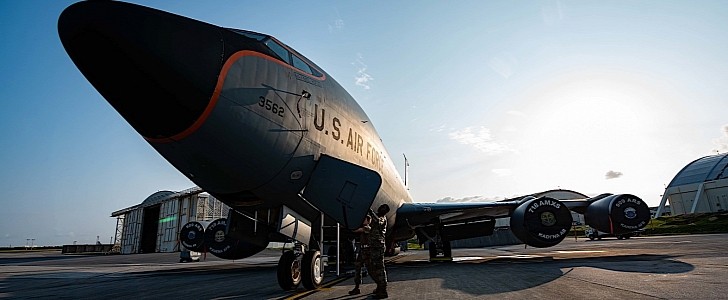There is no doubt about the fact the KC-135 Stratotanker is one capable flying machine, but no one can really say this flying gas station is a mean-looking (or mean-acting) beast. Yet, this is exactly the message the family sends across in this pic here, showing one of its members on the tarmac of an air base in Japan.
The KC-135 Stratotanker forms the backbone of the American Air Force’s (USAF) aerial refueling fleet. Flown for the first time back in the 1950s as the USAF’s first jet-powered refueling tanker, it still is around, and in relatively large numbers (close to 400 of them), serving the needs of the American military on various locations around the world.
Derived from the Boeing 367-80 prototype, which also spawned the 707 commercial airliner, the KC-135 is powered by four CFM International turbofan engines that develop 21,634 pounds of thrust each. That’s more than enough to get the plane off the ground while weighing 322,500 pounds (over 146 tons), of which more than half, 200,000 pounds (almost 91 tons), can be fuel.
Modernized constantly over the decades, the Stratotanker is one of the most present airplanes in the pics the Air Force releases constantly, either as the star of them or as the platform amateur photographers use to snap instances of other airplanes as they come in to refuel.
In this case, the tanker is the star. It’s a bird flying with the 909th Air Refueling Squadron, seen here on the tarmac of the Kadena Air Base in Japan, from where it was getting ready to take off for “routine readiness training” at the beginning in March.
The plane was snapped before actually rolling onto the tarmac, and a closer look shows covers are still drawn over the engines, just as some of the crew is boarding the plane.
Derived from the Boeing 367-80 prototype, which also spawned the 707 commercial airliner, the KC-135 is powered by four CFM International turbofan engines that develop 21,634 pounds of thrust each. That’s more than enough to get the plane off the ground while weighing 322,500 pounds (over 146 tons), of which more than half, 200,000 pounds (almost 91 tons), can be fuel.
Modernized constantly over the decades, the Stratotanker is one of the most present airplanes in the pics the Air Force releases constantly, either as the star of them or as the platform amateur photographers use to snap instances of other airplanes as they come in to refuel.
In this case, the tanker is the star. It’s a bird flying with the 909th Air Refueling Squadron, seen here on the tarmac of the Kadena Air Base in Japan, from where it was getting ready to take off for “routine readiness training” at the beginning in March.
The plane was snapped before actually rolling onto the tarmac, and a closer look shows covers are still drawn over the engines, just as some of the crew is boarding the plane.









